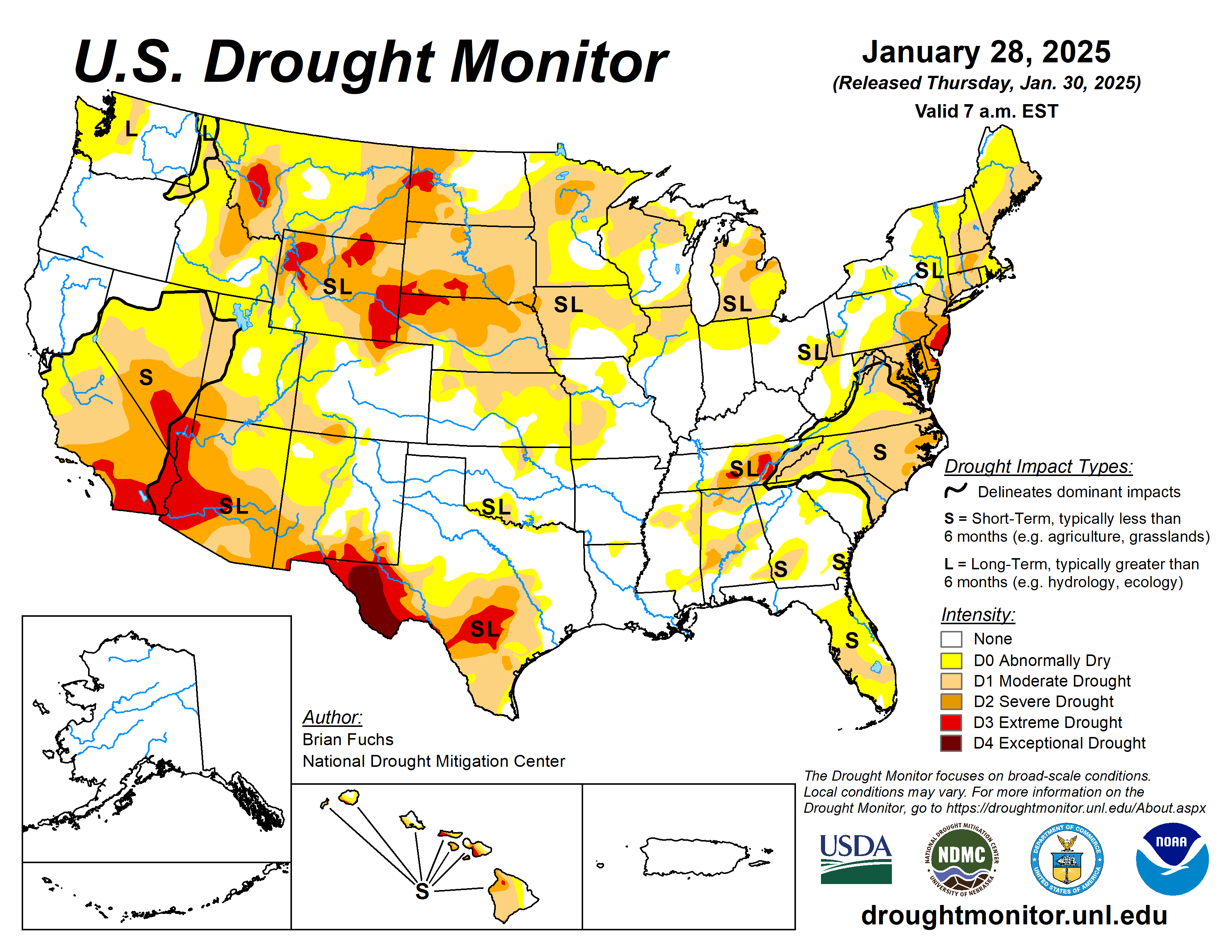A dry week dominated the weather over much of the country with only portions of southern California and in the South along the Gulf Coast recording significant precipitation for the week.
The current week started with a significant, even historical, winter storm event that impacted the coastal areas of the Gulf Coast. Several locations set all-time records for snow amounts with some locations in Louisiana having 9 to 10 inches of snow for the event. Some locations in the Florida panhandle also recorded 6 to 9 inches of snow during this event.
Colder-than-normal temperatures dominated the country with the coldest readings in the Southeast, where departures were 10 to 15 degrees Fahrenheit below normal, and in the northern Rocky Mountains with similar departures from normal. Portions of the northern Plains were warmer than normal, with temperatures 5 to 10 degrees above normal in the Dakotas and into portions of eastern Montana and western Minnesota.
The U.S. Drought Monitor is jointly produced by the National Drought Mitigation Center at the University of Nebraska-Lincoln, the U.S. Department of Agriculture and the National Oceanic Atmospheric Administration. (Map courtesy of NDMC.)
South
Most of the region was dry for the week outside of those areas impacted by the winter storm that traversed across the Gulf Coast areas of Texas and into central Louisiana and Mississippi.
Temperatures were cooler than normal over the entire region with the greatest departures over southern Louisiana into Mississippi where temperatures were 12 to 16 degrees below normal. Improvements were made to the abnormally dry conditions in Mississippi and in portions of east Texas. Severe and extreme drought was expanded in southern Texas with regards to the long-term drought signals in place, especially on the hydrologic systems in the region.
Midwest
It was a dry week for the region, outside of the far northern tier along the Canadian border where some areas had normal to above-normal precipitation. Temperatures were colder than normal throughout the region with departures of 6 to 9 degrees below normal except northern Iowa and Minnesota where temperatures were near normal to 3 degrees above.
Most of the area stayed the same this week with only some expansion of moderate drought and abnormally dry conditions in Missouri.
High Plains
Northern areas were warmer than normal with departures of 3 to 9 degrees above normal in the Dakotas and northeastern Montana. Colder-than-normal temperatures dominated the rest of the region with some areas of Wyoming 12 to 15 degrees below normal. Areas of western South Dakota, southwest North Dakota, southeast Montana and northeast Wyoming improved as conditions over the last few months were reassessed and the indicators were not aligning with the drought depiction.
In many instances the drought is still considered severe or worse, but where the intensity was reduced, it was due to not all the indicators converging to what was being shown. In Wyoming, conditions were improved in the central and southwest where severe and moderate drought as well as abnormally dry conditions were improved. Some extreme drought was extended in the Wind River where snow and precipitation numbers supported the change.
West
Temperatures were colder than normal over almost the entire region, with departures of 9 to 12 degrees below normal in the northern Rocky Mountains and 3 to 6 degrees below normal most other places. Most of the region was drier than normal only eastern Montana recording above-normal precipitation. Abnormally dry conditions were filled in over northwest Montana. In Colorado, abnormally dry conditions and moderate drought expanded over the west, south and southwest portions of the state with a new area of severe drought added in the south.
Looking ahead
Over the next five to seven days, it is anticipated that some of the coastal areas of the Pacific Northwest could see some dryness alleviated with rains from northern California to Washington. Precipitation chances appear to be good over the northern and central Rocky Mountains.
The most active rainfall pattern is expected to be from the southern Plains where some areas of Texas, Oklahoma and Arkansas will see 2 to 3 inches of rain. Dry conditions will continue in the Southwest and northern Plains along with most of the Florida peninsula.
The 6- to 10-day outlooks show that the probability of below-normal temperatures is greatest in the Pacific Northwest and across the northern part of the United States into the High Plains. The best chances of above-normal temperatures will be over the Four-Corners region and along the southern tier of the U.S. into the Southeast and Mid-Atlantic. The greatest chances of above-normal precipitation will be over northern California into the Great Basin and the northern Rocky Mountains as well as over the Midwest. The best chances of seeing below-normal precipitation are over the Southwest and along the Gulf Coast of Florida.
Brian Fuchs is with the National Drought Mitigation Center.




